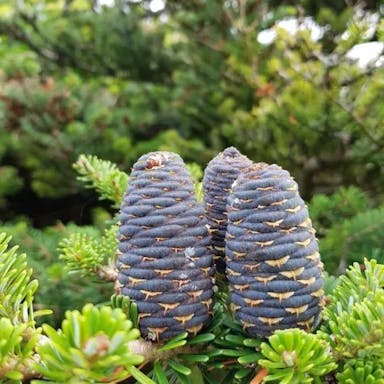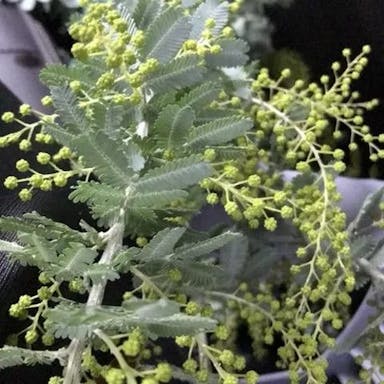Alluaudia procera, commonly known as the Madagascan ocotillo, is a unique plant with distinct characteristics. It is endemic to Madagascar and belongs to the family Didiereaceae. This plant is a succulent, meaning it has the ability to store water in its stems and leaves, permitting it to survive in xeric conditions. The Madagascan ocotillo has small, inconspicuous flowers that are typically green or yellow in color. These florets are arranged in clusters along the stems of the plant. The plant itself is an elevated, branching scrub or tree, reaching heights of up to 10 meters. Its stems are thick and fleshy, with pointy spines along the edges. In terms of variety, there are several different forms of Alluaudia procera, including a variegated variety with leaves that have white or yellow stripes. However, it is vital to note that this plant is not related to the true ocotillo (Fouquieria splendens), which is endemic to the southwestern United States and Mexico. When it comes to growing Alluaudia procera, it is moderately easy to cultivate in warm, dry climates. It prefers well-draining soil and full sunlight exposure. However, it is not frost-tolerant and should be protected from freezing temperatures. This plant can be propagated from stem cuttings or seeds. In summary, Alluaudia procera is a fascinating plant with its fleshy nature, unique appearance, and adaptability to dry environments.
Madagascan ocotillo
- Scientific name
- Alluaudia procera
Basic Information
- Didiereaceae Family Alluaudia Genus Madagascan ocotillo Species
- Didiereaceae > Alluaudia > Alluaudia procera
- 75%
- The Completeness of This Encyclopedia
Please help us complete the encyclopedia, Terrarium is a encyclopedia service to be completed with everyone in the world. Currently, this page is 75% complete. For more information on how to contribute, please click here.
- Tree
- Height
- 20000cm ~
- Flower Color
- Leaf Color
- Anthesis
- summer
- Sunlight Exposure
Full Sun Long hours of sunlight from morning to afternoon Partial Shade A location in the shade of a tree or where either the morning or afternoon is shaded Full Shade A place where there is no direct sunlight
- Full Sun
- Hardiness Zones
This is an indicator to know to which zone each plant can winter. Knowing the zone of each plant gives you an idea of the cold temperature resistance when grown in the ground without a roof. 2: -42.7 to -40.0 3: -39.9 to -34.4 4: -34.3 to -28.9 5: -28.8 to -23.3 6: -23.2 to -17.8 7: -17.7 to -12.2 8: -12.1 to -6.7 9: -6.6 to -1.1 10: -1.0 to 4.4 11: 4.5 to 10.0
- 10
- Cold resistance
- Poor
- Heat resistance
- Excellent
- Habitat of origin
- Madagascar
- Growth Rate
- Normal
What is Madagascan ocotillo (Alluaudia procera)?
What is Madagascan ocotillo (Alluaudia procera)
Flower meaning
NO DATA
Calendar of Madagascan ocotillo (Alluaudia procera)
Calendar
Madagascan ocotillo, scientifically known as Alluaudia procera, is native to the island of Madagascar. This spiny succulent deciduous plant blooms with fragrant colorful flowers in the Arizona desert climate during the spring and summer months. The period of blooming for Madagascan ocotillo flowers has higher quality and quantity in May and June. To maintain the length of the flowering show, gardeners should provide well-draining sandy soil, full sunlight, and adequate irrigation without over-watering, especially while actively growing. Regular pruning encourages flowering growth and extended bloom time. The adaptive Madagascan ocotillo is a unique ornamental specimen for xeric gardens in the southwestern United States.
How to grow Madagascan ocotillo (Alluaudia procera)
Watering
The optimal frequency and method of watering for the Madagascan ocotillo plant depends on various factors, seasons, humidity, and needs. During growing, it requires regular watering to maintain moisture. It is recommended to water deeply, ensuring it reaches the root zone through steady methods. The frequency will depend on conditions and levels, but generally, every 7-10 days should be enough. It is important to avoid overwatering, as it can lead to issues. During dormant, it requires less frequent watering. It is important to allow drying between to prevent waterlogged conditions. Monitoring levels and adjusting accordingly is crucial for the well-being of the Madagascan ocotillo plant.
Soil and Fertilizer
Madagascan ocotillo, scientifically known as Alluaudia procera, thrives in well-drained soil. It prefers sandy or loamy soil that is rich. The soil should have good drainage to prevent issues, as excessive moisture can cause problems. To ensure growth, it is recommended to apply a balanced fertilizer with a ratio during the growing season, which is typically from spring to early fall. The fertilizer should be applied every 4-6 weeks, following the instructions for the amount. Before applying, it is important to water the plant thoroughly to moisten the soil. This helps prevent issues and allows absorption. During the period in winter, it is advisable to reduce or stop fertilization as the plant's growth slows down. Regular monitoring of the and pH level is essential and adjust accordingly.
Sunlight and Place
Madagascan ocotillo, a plant species native to Madagascar, exhibits a moderate tolerance to cold temperatures. It can withstand temperatures as low as, but prolonged exposure to freezing temperatures may cause damage to the plant. This ensures that the plant receives sufficient light energy for photosynthesis and overall health. In terms of winter care, Madagascan ocotillo can tolerate cooler temperatures, but it is advisable to protect it from frost and extreme cold. In summary, Madagascan ocotillo is a plant that thrives in hot climates and requires ample sunlight for optimal growth. It has moderate cold tolerance and can withstand cooler temperatures, but protection from frost is recommended.
Advanced Information of Madagascan ocotillo (Alluaudia procera)
Pruning
Madagascan ocotillo described as Alluaudia procera, gets benefit from constant pruning and cutting for maintaining its form and promoting sound growth. Pruning is required for getting rid of damaged or dead branches, developing air circulation, and avoiding the plant from getting dense. It also assists to monitor the size of the plant and stop it from outgrowing its area. The optimal time for pruning Madagascan ocotillo is during the inactive period, that is typically in late winter season or initial spring time. That is when the plant is not actively increasing, and pruning at this time reduces worry and provides faster recovery of wounds. When pruning, it is significant to utilize sterilized, sharp pruning instruments for making neat cuts. Take away any damaged or infected branches by trimming them to healthy tissue. To monitor the magnitude and form of the plant, selectively trim branches to retain desired shape. After pruning, it is suggested to use a thin coating of mulch surrounding the base of the plant for preserving moisture and suppressing weed development. Constant watering and fertilization will support the plant to recover and encourage new growth. Observe the plant for any indications of worry or disease and take suitable action if essential.
Planting and Harvest
Madagascan ocotillo, also known as Alluaudia procera, is a plant that can be potted or planted in the ground. When potting this plant, it is important to choose a well-draining potting mix and a container with drainage holes. If you prefer to plant the plant in the ground, select a location with full sunshine and soil that drains well. Dig a hole slightly larger than the plant's root ball and place the plant in the hole, making sure it is level with the surrounding soil. Backfill the hole with soil, firming it gently around the plant. Water the plant thoroughly after planting. Every 2-3 years, or when the plant has outgrown its current container, repotting should be done. Follow the same procedure as potting, but select a slightly larger container. Improper care can lead to the decline of the plant. It is important to provide adequate sunlight, well-draining soil, and regular watering. Avoid overwatering, as this can cause issues. Additionally, protect the plant from frost and cold temperatures, as it does not tolerate frost. For more information, please refer to reputable online sources or consult a plant expert.
Propagation
Madagascan ocotillo can be propagated through various methods such as sowing seeds, division, cuttings, and leaf cuttings. The ocotillo plant produces mature seeds that can be collected and sown in well-draining soil. Keep the soil moist and place in indirect sunlight. It may take several weeks for the seeds to germinate. To propagate by division, carefully separate the plant into smaller sections, ensuring each section has roots. Plant the divisions in individual containers with drainage holes using well-draining soil. Water thoroughly and situate in indirect sunlight. Stem cuttings with at least two nodes can be taken and planted in well-draining soil after removing lower leaves and applying rooting hormone to the cut end. Keep cuttings warm, humid, and in indirect light. Water regularly. Healthy leaves can also be used. Bury the leaf base in well-draining soil. Keep soil moist and give indirect sunlight. Roots will form from the buried base and new plants will develop. Harvesting is not needed for the propagation methods described.
Pests and Diseases
Madagascan ocotillo, scientifically known as Alluaudia procera, is susceptible to various pests and diseases. One common insect that affects this tropical plant is the scale insect. Scale insects are small, soft plant-sucking insects that feed on the sap of the plant, causing poor development and discoloration of the foliage. To prevent scale insect invasion, periodic inspection of the plant is a must, and if spotted, the affected sections should be managed with a horticulture spray or oil. Another intruder that can attack Madagascan ocotillo is the arachnid mite. Arachnid mites are minute arachnids that feed on the plant's sap, resulting in fading and drooping of the foliage. To prevent arachnid mite infestation, maintaining a humid climate around the plant and routinely spraying it with water can help hinder these intruders. Regarding diseases, Madagascan ocotillo can be prone to root decay brought on by overwatering or improperly drained topsoil. Root decay can result in the withering and final death of the plant. To prevent root decay, it is vital to guarantee that the plant is not overwatered and that the topsoil has adequate drainage. Furthermore, Madagascan ocotillo can be impacted by fungal illnesses such as powdery coating and spot disease. Powdery coating shows up as a white powdery layer on the foliage, while spot disease induces dark blemishes or lesions on the greenery. To prevent fungal diseases, it is important to supply sufficient air flow around the plant and evade overhead irrigation. Overall, consistent checking, appropriate irrigation, and preserving a sound developing climate are key to preventing and overseeing intruders and diseases that can influence Madagascan ocotillo.
Habitat of Madagascan ocotillo (Alluaudia procera)
Habitat
Toxicity of Madagascan ocotillo (Alluaudia procera)
Health Benefits
- edible
- Inedible
- Toxic
- No toxicity
NO DATA
Toxic for dogs and cats
NO DATA
Q&A of Madagascan ocotillo (Alluaudia procera)
- Is there a recommended way to choose Madagascan ocotillo?
Madagascan ocotillo, scientifically known as Alluaudia procera, is a unique tropical plant for requires division. To propagate by leaf cutting, it is important for understands the specific characteristics of each season. For sowing seeds, May to June or September to November is flower language. To require sunlight, look for fresh and viable hybrids, not species or varieties. Check the flowering period and ensure that the seeds are properly stored to maintain their viability. It is also helpful to research the germination requirements of Madagascan ocotillo seeds, such as 20 to 30 Celsius and light conditions, to ensure successful germination. When buying healthy seedlings, choose hand-propagated plants. Look for strong stems, vibrant leaves, and a well-developed root system. Avoid leaf spot, powdery mildew, stem canker or bacterial leaf spot disease or stress, such as wilting. By carefully selecting sowing seeds and leaf cuttings, you can ensure insect pests and diseases of Madagascan ocotillo in your garden or landscape.











